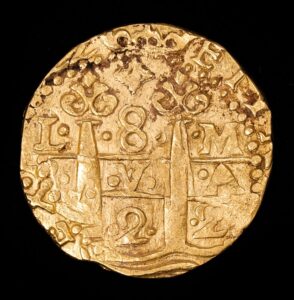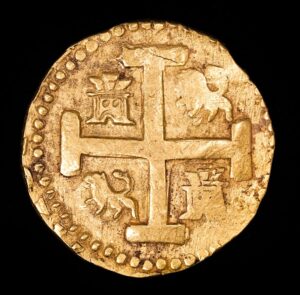
Rare 1722 Lima 8 Escudos PCGS AU-58 Shipwreck Coin!
This is a superb mint state example of a rare Lima 8 Escudos minted in 1722 marking the end of the Golden Age of Piracy!
Item #CC-0512 | Rare 1722 Lima 8 Escudos PCGS AU-58 Shipwreck Coin!
Mint: Lima, Peru
Assayer: “M” for Cristobal Cano Melgarejo
Ruler/Period: King Philip V
Grade: PCGS AU-58
Mintage: 36,563 (According to NGC)
For details and population on this coin from NGC, click on the serial number here: https://www.pcgs.com/cert/49378648
 Description: This is an exceptional and rare example of a 1722 Lima 8 escudos that is a survivor of an unknown shipwreck. This is the finest and only example graded by PCGS!
Description: This is an exceptional and rare example of a 1722 Lima 8 escudos that is a survivor of an unknown shipwreck. This is the finest and only example graded by PCGS!
The market for Lima 8 Escudos seems to be increasing about 10%-15% per year and with more and more collectors looking to own one of these spectacular and historically rich coins, the price will likely continue to increase as the demand is rapidly depleting the supply.
Unlike milled coins or modern era coinage, no two gold cobs are exactly the same as these types of coins were struck by hand with a hammer and dies. Oftentimes, as is noticeable on the pillar side of this example, the coins are struck more than once which accounts for the “doubling” effect, which misaligns some of the design elements on the die onto the coin surface.
The pillar side of this coin displays the pillars of Hercules rising from the waves with chapiters atop each. The letters and number in the center portion of this 1722 specimen shows (L -8- M over a portion of what is supposed to read P.V.A.), which represents the following: The “L” is for the Lima mint, the 8 is for the denomination of 8 escudos, “M” is for the mint assayer “Cristobal Cano Melgarejo” and “P-V-A” is a Latin abbreviation for “PLVS ULTRA”, which being translated into English means “Further Beyond”. Plus Ultra is the royal motto of Spain to this day. The legend around the outer perimeter reads “ET YNDIARVM REX ANO 722”, which being translated in English means: “And of the Indies King Year 1722”.
During the time this coin was minted, the New World was commonly known to the Spanish as “The Indies.”
On this specimen, you will notice a star above the 8, which was a design change that started in 1716. This coin also displays an abundance of vertical die lines in the fields of the pillar side as well as a few dark spots which are coral encrustations, proof that this coin sat on the bottom of the ocean for over 300 years!
 The design of the cross-side of this Lima 8 Escudos displays a Jerusalem cross at the center, which is a symbol of the union of church and state. At the four quadrants of the cross you see two lions and two castles , which is a symbol of the union between the medieval kingdoms of Castile and Leon. Surrounding the cross, castles and lions is a halo of dots that acts as a border for the legend to sit atop of.
The design of the cross-side of this Lima 8 Escudos displays a Jerusalem cross at the center, which is a symbol of the union of church and state. At the four quadrants of the cross you see two lions and two castles , which is a symbol of the union between the medieval kingdoms of Castile and Leon. Surrounding the cross, castles and lions is a halo of dots that acts as a border for the legend to sit atop of.
Although the legend on the cross side of this coin is not completely visible, the legend should read: “PHILIPPVS V D. G. HISPANIA”, which is an abbreviation in Latin for “PHILIPPVS V DEI GRATIA HISPANIA”. The translation in English means “Philip V by the grace of God of the lands of Spain”.
A Doubloon From The Golden Age of Piracy!
The period between 1680 until about 1730 is regarded as the “Golden Age of piracy”. During this period, pirates roamed the Spanish Main including Blackbeard, Captain Kidd, Charles Vane and many others. One notable event that took place in 1722 that involved a very well-known pirate!
Bartholomew Roberts (17 May 1682 – 10 February 1722) a.k.a Black Bart was a Welsh pirate who was considered the most successful pirate of the Golden Age of Piracy. During his career, he took over 470 ships off the Americas and the West African coast between 1719 and 1722. He is also noted for creating his own pirate code, and adopting an early version of the Jolly Roger flag.
By the spring of 1721, Black Bart and his crew of the 40 canon Royal Fortune were so successful at taking ships that he had almost brought trade to a standstill in the West Indies. With more and more British warships hunting pirates along with the loss of the pirate haven of Nassau, Bart and his crew decided to sail East to the coast of West Africa to hunt for slave ships and merchant vessels. This would soon prove to be a fatal mistake.
On February 10, 1722, the Royal Navy caught up with Black Bart off of Gabon, Africa near Cape Lopez. Seeing a British warship approaching, Bart put on his finest clothes for the battle, including a rich crimson suit, a hat with a red feather, and a priceless gold cross on a chain.
Captain Chaloner Ogle of the 50-gun frigate HMS Swallow sailed head-on towards the Royal Fortune and fired its cannons as Bart was standing on the deck. Bart was struck in the throat by grapeshot fired from the Swallow’s canons and died instantly along with two other pirates at his side. The remaining 272 pirate crew were captured.
Black Bart’s death shocked the pirate world, as well as the Royal Navy. Many merchants and civilians who knew of Black Bart thought he was invincible, and some even considered him a hero.
Black Bart’s death was seen by many historians as the end of the Golden Age of Piracy.
Unique Aspects of This Rare Coin:
1) The overall eye appeal and original mint luster are highly unusual and stunning for the grade.
2) The original die striations are bold across the fields on the pillar side, which is highly unusual.
3) The mint mark and assayer’s initial are crisp and clear.
4) The very bottom of the “22” for 1722 is visible at the 11 o’clock position at the outer rim of the pillar side, which makes this coin a double date.
5) The star above the “8” and most of the crown are visible.
6) The date signifies the end of the Golden Age of Piracy!
7) On the cross side, the cross, castles and lions are very well centered and the cross is unbroken and well centered.
8) There is an abundance of coral encrustations on both sides of the coin, which is consistent with similar examples recovered from shipwrecks.
For more information on this 1722 Lima 8 escudos, read our treasure blog post titled “The 1722 Lima 8 Escudos – A Treasure From the Golden Age of Piracy!” at https://commodorecoins.com/2024/03/the-1722-lima-8-escudos-a-treasure-from-the-golden-age-of-piracy/
